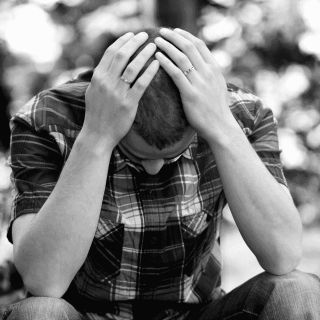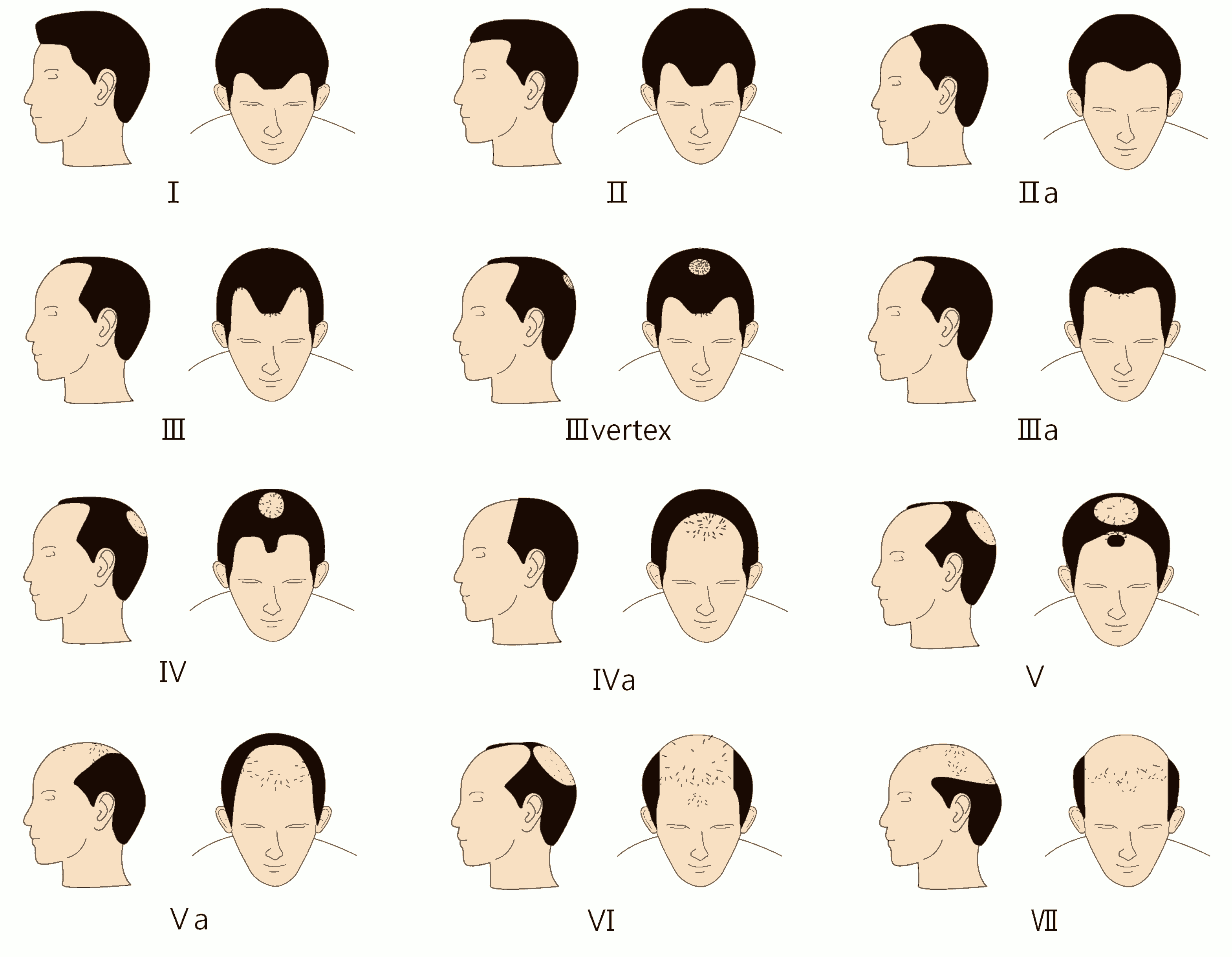

Because a full head of hair is sometimes seen as youthfulness and a display of strength, when a man starts to lose his hair, stress, frustration, and a loss of self-esteem can settle in. More than just aesthetics and appearance, many men feel powerless because they cannot control the hair loss, and depressed because they feel that the loss has to do with their mortality and the passage of time. Hair restoration helps countless men overcome these feelings by restoring their hair loss and creating fuller, thicker heads of hair.
The most common type of hair loss among men is male pattern baldness, known as androgenetic alopecia. This affects up to 80% of men by the age of 80. It is a condition caused by age, genetics and a specific hormone called DHT (dihydrotestosterone) that attacks hair follicles leading to a disturbance of the normal hair growth cycle. (There are many myths regarding hair loss, such as shampooing or hats causing hair to fall out. Find out the truth behind these myths here.) The disturbance to the normal hair growth cycle causes follicles to shrink and grow at a slower pace, eventually leading to the hair falling out and the pattern repeating itself with other hair follicles in different regions of the scalp. This process can affect the while scalp, except for the hair at the back and sides of the head, which is not subject to male pattern baldness. This is a genetically permanent zone, which makes it a suitable solution to be used for hair transplant surgery. Read more about hair growth and hair loss here.
Unfortunately, the onset, rate and severity of hair loss are often unpredictable, but we do know that hair loss may begin at anytime after puberty when blood levels of male hormones rise. In most cases, male pattern baldness starts in the late 20’s and early 30’s. It is usually subtle at first, followed by alternating periods of slow and rapid hair loss, interspersed between periods of stability. The frontal area is usually the first place where hair is lost. This usually involves receding of the hairline near the temple areas, which forms an “M” shape. In some men, the loss stops there and never advances, while in other men, hair loss continues into other areas of the scalp, including the the crown. Eventually, these two areas may merge until the entire front, top and crown area are bald, resulting in a U-shaped or “horseshoe” pattern of hair around the sides of the head. In the end, the hair follicles, even those with no genetic predisposition, may succumb to the effects of either the DHT-driven miniaturization process or age related volume loss, which is why most men in their 70’s and 80’s will show some signs of hair thinning or hair loss.
The Norwood Classification Scale has been developed as a universal way to identify a man's stage of hair loss. It separates male pattern baldness into distinct categories ranging from Stage 1, meaning no hair loss, to Stage 7, meaning near total hair loss with hair remaining only around the back and the sides of the scalp (“horseshoe” pattern). Most cases of male pattern baldness follow this pattern although there are other rare patterns such as overall thinning throughout the top of the head. The Norwood Classification Scale categories include:
Stage 1 represents an adolescent or juvenile hairline with very minor or no recession of the hairline. Therefore, no treatment is required.
Stage 2 indicates a progression to the adult or mature hairline where there is mild recession of the frontal hairline, slightly evident at the frontotemporal areas. This also does not represent balding.
Stage 2A represents the deepest recession of the frontotemporal hairline.
Stage 3 is the earliest stage of male hair loss. It is characterized by a deepening frontotemporal recession producing an 'M' shaped pattern. These areas are completely bald or only sparsely covered by hair.
Stage 3A is characterized by deepest recession of the frontotemporal hairline with more extensive thinning in the front.
Stage 3 Vertex represents early hair loss primarily in the crown (vertex).
Stage 4 is characterized by further frontal hair loss and enlargement of vertex, but there is still a solid band of hair across the top (mid-scalp) separating the front and crown.
Stage 4A is similar to Stage 4 only with more thinning on the upper and frontal part of the scalp.
Stage 5 shows intensifying hair loss in the front and crown, and the bridge of hair separating the two areas begins to break down. When viewed from above, stages 5 to 7 show the remaining hair at the sides and back as a distinct horseshoe shape.
Stage 5A is similar to Stage 5 only with extended thinning on the upper and frontal part of the scalp.
Stage 6 occurs when the connecting bridge of hair disappears with only minimal hair remaining. The hair loss on the sides of the scalp has extended further.
Stage 7 is the most severe form of hair loss. Only a narrow band of hair remains on the back and sides of the scalp. This hair may be quite thin.

The diagnosis of typical male pattern baldness is based on the appearance and pattern of hair loss. A comprehensive medical history, including a list of medications, history of hair loss, and a thorough scalp examination is performed. This evaluates the degree of miniaturization of hair follicles and is done to rule out medical conditions, skin disorders of the scalp or nutritional deficiencies that may cause hair loss. Health and/or skin conditions that could lead to hair thinning or hair loss may be associated with scalp itching, redness, tenderness, skin peeling, hair breakage, patchy hair loss, sudden hair shedding or an unusual pattern of hair loss. A scalp biopsy may also be performed if the cause of hair loss is unclear or there is concern for scarring alopecia.
Thankfully, men’s hair loss can be effectively treated with today’s advanced nonsurgical and surgical treatment options. After a diagnosis has been confirmed, your doctor in Korea will create a customized treatment plan depending on your unique hair characteristics, the level of hair loss and the aesthetic goals of the patient.
Nonsurgical solutions include specially compounded FDA approved medications such as Finasteride (brand name: Propecia®) and Minoxidil (brand name: Rogaine®) that are clinically proven to help slow down, stop and even reverse hair loss. Read more about available medications.

For some patients, nonsurgical hair restoration techniques may not be sufficient to restores one’s hair loss, especially patients who have advanced loss. As a result, hair transplantation surgery would be the best approach to restore one’s confidence and quality of life by restoring hair through extremely advanced techniques. Modern surgical hair restoration procedures such as Follicular Unit Transplant (FUT) or Follicular Unit Extraction (FUE) allow doctors to take hair from the back of the head and transplant it to the areas where hair loss has occurred. The reason why the hair does not fall out once transplanted in its new location is because the transplanted hair follicles take on the same characteristics as the hair in the area where it originated, which is the genetically permanent zone. Both approaches result in natural, everlasting outcomes. See the hair transplant growth timeline here. The primary difference between the two techniques is in the way in which the hair is extracted. You can find the answers to the most frequently asked questions here. Your Korea-based doctor will determine if you have ample, good quality hair in the permanent hair zone in order to be able to relocate those hair follicles to the areas of hair loss. Contact us now to have a consultation with one of our doctors, who will give you advice on the best way to proceed.

Please send us your email address, and one of our representatives will personally contact you as soon as possible.
Your email address will never be sold or spammed.